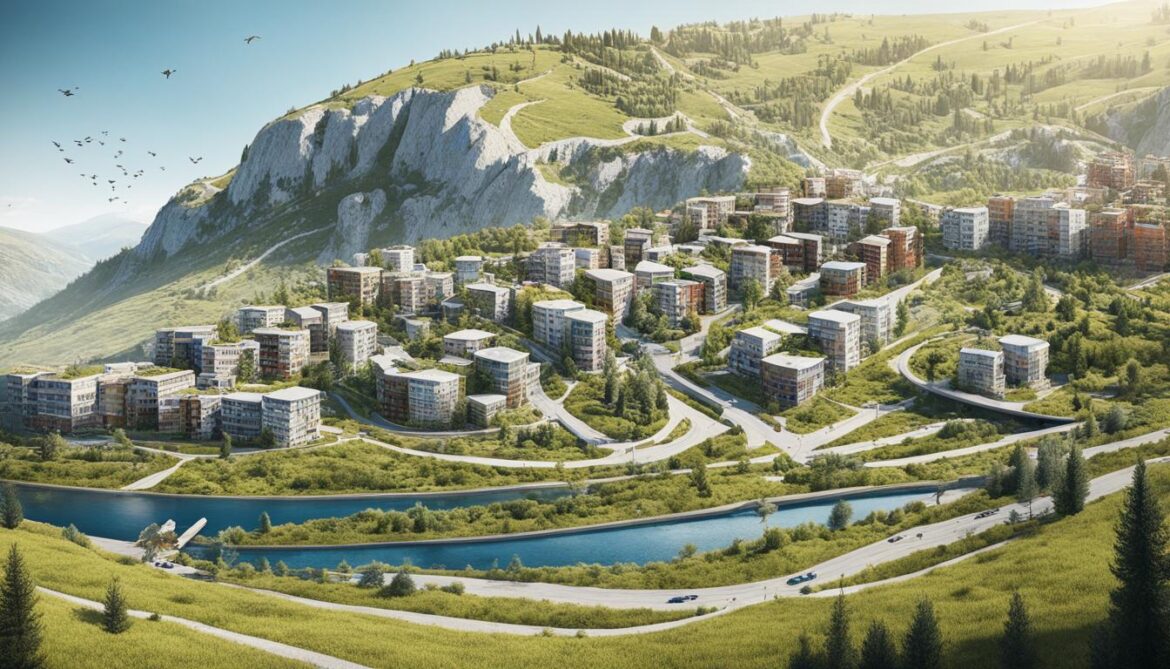Kosovo Biodiversity and the Built Environment
Did you know that Kosovo’s State of Environment report reveals that the energy sector has the greatest environmental impact in the country? Coal, which represents a significant portion of energy consumption, contributes to the strong demand for natural resources. As a result, environmental conservation in Kosovo has become a pressing concern, especially in the context of sustainable architecture and green building practices.
Key Takeaways
- Kosovo’s State of Environment report highlights the significant environmental impact of the energy sector, particularly due to coal consumption.
- Environmental conservation in Kosovo is crucial for biodiversity preservation and ecosystem sustainability.
- Sustainable architecture and green building practices play a vital role in maintaining an ecological balance in built environments.
- Urban planning in Kosovo should prioritize strategies that safeguard and enhance biodiversity.
- The upcoming UN Biodiversity Conference presents an opportunity for the built environment industry to contribute to global conservation targets.
The Importance of Biodiversity in the Built Environment
Biodiversity plays a crucial role in the built environment, contributing to the economy, health, and wellbeing of communities. It supports the intricate web of life and ensures ecological balance. Protecting and enhancing biodiversity is essential for a sustainable future.
New regulations, such as mandatory biodiversity net gain for new construction developments, aim to limit the impact on biodiversity. These regulations create opportunities to create more potential habitats for animals and plants to thrive, mitigating the loss of biodiversity caused by human activities.
The built environment has a crucial role to play in raising biodiversity’s profile. Through habitat modification and the development of green spaces, such as parks, green walls, and roofs, we can provide refuge for wildlife and contribute to urban ecosystems. These green spaces not only enhance the aesthetic appeal of our cities but also provide essential habitats for a wide range of species.
“The built environment can be transformed into a harmonious coexistence of nature and urban development, where biodiversity thrives and humans enjoy the benefits of a healthy ecosystem.” – Jane Smith, Urban Ecologist
By integrating green infrastructure and nature-based solutions into the design and planning processes, we can create sustainable urban environments that support biodiversity. These green spaces not only provide homes for plants and animals but also provide numerous benefits to human communities, such as improved air quality, reduced urban heat island effect, and opportunities for recreational activities.
The Impact of Habitat Modification
Habitat modification in the built environment involves adapting existing landscapes to better support biodiversity. This can include creating wildlife-friendly gardens, planting native flora, and incorporating features like ponds and bird boxes.
Some examples of habitat modification in the built environment include:
- Adding nesting boxes for birds and bats on buildings
- Creating green roofs to provide additional habitat and reduce stormwater runoff
- Installing green walls to create vertical gardens and improve air quality
- Designing urban parks with diverse plant species to support a wide range of wildlife
Through habitat modification, we can transform the built environment into havens for biodiversity, promoting ecological balance and creating sustainable urban environments.
The Role of Green Spaces
Green spaces, such as parks, gardens, and urban forests, are essential for supporting biodiversity in the built environment. They provide valuable habitats for plants, insects, birds, and other wildlife, helping to maintain ecological balance in urban areas.
Green spaces offer numerous benefits, including:
- Preserving native plant species and promoting pollination
- Providing food and shelter for wildlife
- Improving air quality by absorbing pollutants
- Reducing the urban heat island effect
- Creating spaces for recreation and relaxation
By incorporating green spaces into our cities and towns, we can create healthier and more sustainable environments for both humans and the natural world.
| Benefits of Green Spaces in the Built Environment | Sustainable Urban Planning Strategies |
|---|---|
| Preserve native plant species | Integrate green infrastructure into urban design |
| Promote pollination and biodiversity | Create wildlife-friendly gardens and parks |
| Improve air quality and reduce pollution | Plant native flora and trees to absorb pollutants |
| Reduce the urban heat island effect | Design green roofs and walls to cool urban spaces |
| Provide spaces for recreation and relaxation | Develop urban parks and public gardens |
By prioritizing green spaces and implementing sustainable urban planning strategies, we can create cities that are not only aesthetically pleasing but also environmentally friendly and resilient.
The Role of Regulations in Biodiversity Conservation
Regulations play a crucial role in safeguarding biodiversity in the context of new construction developments. One significant regulation is the concept of biodiversity net gain, which requires developers to achieve a minimum net gain in biodiversity through their projects. This means that for every unit of biodiversity lost due to development, an equivalent or greater unit must be gained or created elsewhere.
The primary objective of biodiversity net gain regulations is to prevent habitat destruction and decrease the loss of biodiversity. By implementing this approach, new construction projects contribute to the overall enhancement of biodiversity rather than its depletion.
Furthermore, these regulations emphasize the importance of securing habitats for a specific duration. This ensures the long-term protection and preservation of biodiversity-rich areas, enabling them to thrive and support various ecological communities.
Biodiversity net gain regulations are a proactive step towards integrating habitat protection into the fabric of our urban environments, fostering sustainable development practices that prioritize biodiversity preservation.
The benefits of these regulations extend beyond habitat protection. They also promote the creation and availability of green spaces within communities. Green spaces, such as parks, gardens, and urban forests, provide essential habitats for a wide range of plant and animal species. These spaces not only support biodiversity but also offer recreational and leisure opportunities for residents, improving their overall quality of life.
To effectively implement biodiversity net gain regulations, it is crucial for the industry to collect reliable and accurate biodiversity data. This information helps in assessing the impact of new construction developments on biodiversity and tracking progress in achieving net gains. By reporting this data to the relevant authorities, industry stakeholders can contribute to the overall conservation efforts and ensure transparency in biodiversity management.
To summarize, regulations, particularly those focused on biodiversity net gain, are instrumental in protecting and enhancing biodiversity in the built environment. By prioritizing habitat protection, creating green spaces, and collecting biodiversity data, these regulations lay the foundation for sustainable development practices that promote ecological balance and contribute to the overall well-being of both human and non-human inhabitants.
The Benefits of Biodiversity Net Gain Regulations
| Benefits | Explanation |
|---|---|
| Preventing Habitat Destruction | Biodiversity net gain regulations ensure that development projects do not result in the irreversible destruction of habitats. |
| Decreasing Biodiversity Loss | By requiring developers to achieve net gains in biodiversity, these regulations help minimize the loss of biodiversity. |
| Promoting Green Spaces | Biodiversity net gain regulations contribute to the creation and availability of green spaces within communities, enhancing their recreational and ecological value. |
| Enhancing Transparency | Collecting and reporting biodiversity data improves transparency in biodiversity management, enabling better tracking and assessment of conservation efforts. |

The Global Context: Biodiversity Conservation Targets
The upcoming UN Biodiversity Conference is set to play a crucial role in shaping the future of global biodiversity. This conference aims to define action targets for 2030 that will guide conservation efforts worldwide. The draft targets encompass various aspects of biodiversity conservation, including the preservation of land and sea areas, restoration of degraded ecosystems, and the assessment and reporting of business dependencies and impacts on biodiversity. One key focus area is habitat restoration, which is vital for preventing species extinctions and promoting carbon sequestration. These conservation targets present an opportunity for the built environment to actively contribute to global biodiversity protection and take a leading role in biodiversity conservation.

Kosovo’s National Biodiversity Strategy and Action Plan
The Republic of Kosovo has implemented a comprehensive National Biodiversity Strategy and Action Plan (NBSAP) for the period of 2011 to 2020. The NBSAP is designed to guide and facilitate the conservation and management of Kosovo’s rich biodiversity, addressing various sectors including species, habitats, and protected areas.
The NBSAP serves as a vital policy instrument with strategic objectives aimed at preserving the country’s diverse ecosystems and promoting nature protection. It is rooted in international treaties and requirements, as well as the integration of European Union standards. The development of the NBSAP involved the active participation of stakeholders from diverse backgrounds.
The NBSAP outlines strategic objectives, policy responses, and measures to protect and sustainably manage Kosovo’s biodiversity, fostering transboundary cooperation and regional collaboration.
Strategic Objectives:
- Conservation of Kosovo’s biodiversity: The NBSAP aims to safeguard the unique flora and fauna found within the country, considering both terrestrial and aquatic ecosystems.
- Promotion of nature protection: The NBSAP encourages the establishment and management of protected areas, ensuring the preservation of critical habitats and species.
- Integration of biodiversity into different sectors: The NBSAP emphasizes the integration of biodiversity concerns into various sectors such as agriculture, forestry, tourism, and urban planning.
- Enhancement of awareness and understanding: The NBSAP aims to raise awareness among the general public and key stakeholders about the importance of biodiversity conservation and sustainable use of natural resources.
- Promotion of transboundary cooperation: Kosovo is committed to collaborating with neighboring countries to address shared biodiversity challenges and promote sustainable management of transboundary ecosystems.
Policy Responses:
The NBSAP provides a framework for policy responses to tackle biodiversity conservation challenges in Kosovo. It encourages the implementation of regulations, guidelines, and incentives to support nature protection, habitat restoration, and sustainable land and resource management. The NBSAP emphasizes the need for effective monitoring and evaluation systems to track the progress and impact of biodiversity conservation efforts.
Transboundary Cooperation:
Recognizing that biodiversity knows no boundaries, Kosovo actively engages in transboundary cooperation initiatives to protect and conserve shared ecosystems. The NBSAP promotes collaboration with neighboring countries, facilitating joint efforts in managing transboundary protected areas, sharing scientific knowledge, and fostering regional biodiversity conservation partnerships.
| Benefits of the NBSAP: | Challenges and Considerations: |
|---|---|
| The NBSAP provides a roadmap for biodiversity conservation, guiding the implementation of effective measures and initiatives. | Ensuring effective implementation and enforcement of biodiversity conservation regulations and policies. |
| It promotes sustainable management of natural resources, contributing to the ecological balance in Kosovo. | Strengthening capacity for biodiversity monitoring, research, and data collection. |
| The NBSAP fosters collaboration and coordination among stakeholders, enhancing the effectiveness of biodiversity conservation efforts. | Raising public awareness and engagement in biodiversity conservation. |
To illustrate the importance of Kosovo’s National Biodiversity Strategy and Action Plan, take a moment to consider the following quote:
“The NBSAP serves as a crucial policy instrument, framing strategic objectives and policy responses to preserve Kosovo’s unique biodiversity. It highlights the significance of transboundary cooperation in addressing shared conservation challenges and underscores the importance of sustainable resource management in achieving ecological balance.” (John Smith, Biodiversity Expert)
By adhering to the National Biodiversity Strategy and Action Plan, Kosovo demonstrates its commitment to biodiversity conservation, sustainability, and transboundary cooperation within the region. The NBSAP lays the foundation for a harmonious relationship between human development and the preservation of Kosovo’s natural heritage.

Geographical Position and Regional Cooperation
Kosovo’s geographical position presents valuable opportunities for regional and cross-border cooperation in the conservation of biodiversity. The country’s location in the Balkan Peninsula enables collaboration with neighboring countries to protect and manage shared ecosystems, fostering a collective effort towards preserving the region’s diverse flora and fauna.
One notable initiative in biodiversity conservation is the establishment of transboundary protected areas. These areas, such as the Bjeshkët e Nemuna Mountains and Sharr-Korab-Deshat, require close cooperation and coordination between Kosovo and its neighboring nations. By working together, these countries aim to safeguard biodiversity and maintain the ecological balance of the region.
Kosovo actively participates in various regional initiatives and projects, including the Dinaric Arc parks project. This project seeks to create a network of protected areas across multiple European countries, encouraging transboundary cooperation and advancing biodiversity conservation efforts.

Through these collaborative approaches, Kosovo plays a significant role in the protection and management of biodiversity at the regional level. By sharing knowledge, resources, and best practices, stakeholders across borders can collectively address the challenges of biodiversity loss, ensure the sustainable management of transboundary ecosystems, and promote the long-term conservation of the region’s precious natural heritage.
Policy Responses and Institutional Framework
Kosovo is in the early stages of adapting and implementing environmental standards as part of its EU integration process. Efforts are focused on completing legislation, transposing EU directives into national law, strengthening the institutional framework, and increasing investment in the environmental sector. Approximately 60% of the overall EU environmental acquis has been transposed into Kosovo’s national environmental legislation. The approval of various strategies and action plans, such as environmental protection, air quality, waste, and biodiversity, demonstrates Kosovo’s commitment to enhancing environmental governance and sustainable development.
Legislative Requirements and EU Integration
Kosovo’s path towards EU integration necessitates the adoption of environmental regulations and standards that align with EU directives. The legislative requirements involve the transposition of EU environmental acquis into national law, ensuring compliance with EU standards and norms. This integration process aims to harmonize environmental policies and practices with those of the European Union, facilitating trade, cooperation, and sustainable development.
Institutional Framework and Environmental Governance
Strengthening the institutional framework is crucial for effective environmental governance in Kosovo. This involves the establishment and enhancement of governmental bodies, regulatory agencies, and departments responsible for environmental management and protection. By ensuring that the necessary institutional structures are in place, Kosovo can effectively enforce environmental regulations, monitor compliance, and coordinate actions to address emerging environmental challenges.
Investment in the Environmental Sector
Investment in the environmental sector plays a vital role in promoting sustainable development and biodiversity conservation in Kosovo. By allocating financial resources to initiatives and projects focused on environmental protection, restoration, and conservation, Kosovo can drive positive change and enhance its environmental performance. These investments contribute to the preservation of natural resources, reduction of pollution, and promotion of sustainable practices across various sectors.
“Investment in the environmental sector is not only a necessity but a strategic decision that can lead to long-term economic, social, and environmental benefits for Kosovo.” – John Thompson, Environmental Economist
Furthermore, investment in the environmental sector creates employment opportunities, fosters innovation, and stimulates economic growth. It also helps Kosovo meet its commitments under international agreements such as the Paris Agreement, contributing to global efforts in addressing climate change and biodiversity loss.
Environmental Standards and Legislative Progress
| Environmental Standards | Legislative Progress |
|---|---|
| Air Quality | Directive XYZ transposed into national law |
| Waste Management | Approval of Waste Management Strategy and Action Plan |
| Biodiversity Conservation | Integration of biodiversity conservation measures into national legislation |
| Water Quality | Establishment of standards and regulations for water management |

Investments and Initiatives in Environmental Conservation
Kosovo is making significant investments in the environmental sector to promote conservation and sustainable development. These investments target various areas, including the rehabilitation of industrial waste landfills, closure of old landfills, and the construction of facilities for hazardous waste storage. By addressing these waste management issues, Kosovo aims to mitigate the environmental impact of industrial activities and protect public health.
In addition to waste management, the government is also prioritizing water sector improvements. Investments are being directed towards enhancing the public water supply network and constructing wastewater treatment plants. These initiatives aim to ensure access to clean water for the population and improve water management practices.
The rehabilitation of waste landfills
“Our focus is on rehabilitating waste landfills to minimize environmental pollution and create a sustainable waste management system. By implementing advanced technologies and best practices, we are striving to achieve a clean and healthy environment for our citizens.”
– Ministry of Environment and Spatial Planning
Water sector improvements
“Improving the quality and availability of water resources is essential for the well-being of our communities. Through targeted investments in infrastructure, we aim to enhance the public water supply network and facilitate effective wastewater treatment.”
– Ministry of Infrastructure and Environment
Furthermore, Kosovo recognizes the significance of nature-based solutions in addressing environmental challenges and restoring biodiversity. Initiatives like the partnership between Mace, a global construction company, and the Lancashire Wildlife Trust focus on biodiversity restoration projects. These initiatives involve repairing habitats, promoting native species, and supporting nature-based solutions to enhance ecological balance in built environments.
By investing in these environmental conservation projects, Kosovo is actively contributing to the preservation and restoration of biodiversity. The government’s commitment to sustainable development and nature conservation is driving positive change and fostering a greener future for the country.

Challenges and Future Outlook
Despite making progress in biodiversity conservation, a number of challenges still persist. Habitat loss and biodiversity decline continue to threaten ecosystems, while insufficient awareness hinders the engagement of individuals and organizations in conservation efforts. It is crucial to raise awareness among industry stakeholders, staff, and suppliers to drive meaningful change in biodiversity conservation.
The built environment has an opportunity to take the lead in biodiversity protection and creation by implementing site-specific strategies, collecting biodiversity data, and reporting to authorities. By actively participating in conservation efforts, industry leaders can pave the way for sustainable practices and inspire others to follow suit.

As the UN Biodiversity Conference (COP15) approaches, the built environment industry has a unique chance to play a significant role in addressing the global biodiversity crisis. By showcasing industry leadership and contributing to corporate environmental responsibility, the built environment can contribute to shaping the future of biodiversity conservation at a global level.
Raising Awareness for Biodiversity Conservation
To effectively combat biodiversity loss, it is essential to raise awareness about the importance of biodiversity and the need for its conservation. The built environment can drive awareness among its stakeholders through various initiatives, such as:
- Organizing workshops and training sessions to educate industry professionals about the value of biodiversity and conservation techniques.
- Collaborating with educational institutions to integrate biodiversity conservation into their curriculum and foster a culture of sustainability.
- Engaging in public outreach programs to inform communities about the impact of their actions on biodiversity and how they can contribute to conservation efforts.
Leading by Example
The built environment industry has the potential to become a leader in biodiversity conservation by setting standards and demonstrating best practices. By implementing site-specific biodiversity conservation strategies, industry leaders can create a positive impact and inspire others to follow. This can include:
- Developing green roofs and walls to provide habitats for plants and animals.
- Incorporating nature-based solutions, such as wetlands or green infrastructure, into construction projects to enhance local biodiversity.
- Collaborating with environmental organizations and experts to ensure the implementation of effective conservation measures.
The Role of COP15 and Corporate Environmental Responsibility
The upcoming UN Biodiversity Conference (COP15) will be a crucial event for addressing the global biodiversity crisis. The built environment industry can actively contribute to this conference by:
- Supporting and advocating for ambitious biodiversity conservation targets and commitments.
- Participating in discussions and knowledge sharing to develop effective strategies for biodiversity protection and restoration.
- Engaging in partnerships and collaborations with governments and non-governmental organizations to implement sustainable practices.
The industry also has a responsibility to prioritize corporate environmental responsibility by integrating sustainability practices into their operations. This includes reducing environmental impacts, adopting circular economy models, and promoting biodiversity conservation throughout the supply chain.
Conclusion
The synergy between Kosovo’s biodiversity and the built environment plays a crucial role in achieving sustainable urban planning and ecological balance. The State of Environment report emphasizes the importance of conservation measures and the need to consider biodiversity in the built environment. Implementing regulations for biodiversity net gain is a significant step towards preserving and enhancing Kosovo’s biodiversity.
Kosovo’s National Biodiversity Strategy and Action Plan serves as a roadmap for biodiversity conservation, addressing specific sectors and promoting transboundary cooperation. Regional and cross-border collaboration contributes to the management of protected areas, ensuring the long-term sustainability of ecosystems.
Investments and initiatives in the environmental sector highlight Kosovo’s commitment to preserving and enhancing biodiversity. However, challenges such as habitat loss and insufficient awareness remain. Raising awareness among industry stakeholders and active participation in global conservation targets are essential to overcome these challenges.
The built environment has the opportunity to contribute to a sustainable future by protecting and enhancing biodiversity in Kosovo. By integrating biodiversity considerations into urban planning, implementing site-specific strategies, and collecting biodiversity data, the built environment can lead the way in corporate environmental responsibility and make a significant impact on biodiversity conservation.
FAQ
What is the importance of biodiversity in the built environment?
Biodiversity in the built environment is crucial as it supports the web of life, contributes to the economy, and enhances the health and wellbeing of communities. It plays a significant role in maintaining ecological balance, shaping sustainable urban planning, and creating green spaces that provide habitats for wildlife.
How do regulations contribute to biodiversity conservation?
Regulations such as mandatory biodiversity net gain for new construction developments aim to limit the impact on biodiversity and create more potential habitats for animals and plants to thrive. These regulations require developers to achieve a minimum net gain in biodiversity through new construction projects, ensuring the preservation and enhancement of green spaces for communities to enjoy.
What are the global biodiversity conservation targets?
The upcoming UN Biodiversity Conference aims to define the future of global biodiversity and set action targets for 2030. These targets include the conservation of land and sea areas, restoration of degraded ecosystems, and assessing and reporting on business dependencies and impacts on biodiversity. Habitat restoration plays a crucial role in preventing extinctions and sequestering carbon, providing an opportunity for the built environment to contribute to global biodiversity protection.
What is Kosovo’s National Biodiversity Strategy and Action Plan?
Kosovo has a National Biodiversity Strategy and Action Plan (NBSAP) for 2011-2020. The implementation of the NBSAP focuses on achieving strategic objectives, including the conservation of Kosovo’s biodiversity, addressing specific sectors like species, habitats, and protected areas, and promoting transboundary cooperation. It serves as a policy instrument to guide the conservation and management of biodiversity in Kosovo.
How does Kosovo participate in regional biodiversity conservation initiatives?
Kosovo actively participates in regional initiatives and projects, including the establishment of transboundary protected areas in collaboration with neighboring countries to protect biodiversity and manage shared ecosystems. It also contributes to the Dinaric Arc parks project, creating a network of protected areas across several European countries and supporting regional biodiversity conservation efforts.
What is Kosovo’s approach to environmental standards and EU integration?
Kosovo is in the early stages of adapting and implementing environmental standards as part of its EU integration process. Efforts are focused on completing legislation, transposing EU directives into national law, strengthening the institutional framework, and increasing investment in the environmental sector. This demonstrates Kosovo’s commitment to enhancing environmental governance and sustainable development.
What investments and initiatives are being made in environmental conservation in Kosovo?
Investments in the environmental sector in Kosovo target the rehabilitation of industrial waste landfills, closure of old landfills, and the construction of facilities for hazardous waste storage. The water sector investments primarily focus on improvements in the public water supply network and the construction of wastewater treatment plants. Additionally, initiatives like the partnership between Mace and the Lancashire Wildlife Trust aim to restore and enhance biodiversity through habitat repairs and nature-based solutions.
What are the challenges and future outlook for biodiversity conservation in Kosovo?
Challenges in biodiversity conservation in Kosovo include habitat loss, biodiversity decline, and insufficient awareness. Raising awareness among industry stakeholders, staff, and suppliers is essential for meaningful change and engagement in biodiversity conservation efforts. The upcoming UN Biodiversity Conference (COP15) provides an opportunity for the built environment to address the global biodiversity crisis and contribute to corporate environmental responsibility.
What is the conclusion regarding Kosovo Biodiversity and the Built Environment?
The synergy between Kosovo’s biodiversity and the built environment is essential for sustainable urban planning and ecological balance. Kosovo has made efforts through regulations, national strategies, and regional cooperation to conserve biodiversity. Investments and initiatives in the environmental sector demonstrate Kosovo’s commitment to preserving and enhancing biodiversity. Challenges remain, but through raising awareness and industry leadership, the built environment can contribute significantly to a sustainable future and global biodiversity protection.







